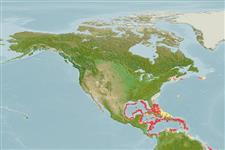>
Argentiniformes (Marine smelts) >
Argentinidae (Argentines or herring smelts)
Etymology: Argentina: Latin, argentus = silver (Ref. 45335); georgei: Named for George Clipper who provided efficient assistance to the authors of this species (Ref. 40914).
More on authors: Cohen & Atsaides.
Environment: milieu / climate zone / depth range / distribution range
Ökologie
seewasser bathydemersal; tiefenbereich 220 - 457 m (Ref. 37039), usually 274 - 402 m (Ref. 40914). Deep-water; 9°C - 17°C (Ref. 37039)
Western Central Atlantic: east coast of Florida to the Dry Tortugas, Bahama Banks, and off the northern coast of Cuba, the Antilles, and Central America.
Size / Gewicht / Alter
Maturity: Lm ? range ? - ? cm
Max length : 14.6 cm SL Männchen/unbestimmt; (Ref. 37039)
Kurzbeschreibung
Morphologie | Morphometrie
Rückenflossenstacheln (insgesamt): 0; Rückenflossenweichstrahlen (insgesamt): 11; Afterflossenstacheln 0; Afterflossenweichstrahlen: 10 - 11. Dark brown with black mid-dorsal stripe dorsally; light with large, dark chromatophores forming band midventrally from isthmus to vent (Ref. 37039).
Found over mud and mud-shell bottoms (Ref. 37039).
Life cycle and mating behavior
Geschlechtsreife | Fortpflanzung | Ablaichen | Eier | Fecundity | Larven
McEachran, J.D. and J.D. Fechhelm, 1998. Fishes of the Gulf of Mexico. Volume 1: Myxiniformes to Gasterosteiformes. University of Texas Press, Austin. 1112p. (Ref. 37039)
IUCN Rote Liste Status (Ref. 130435)
Bedrohung für Menschen
Harmless
Nutzung durch Menschen
Mehr Information
NamenSynonymeMetabolismusRäuberÖkotoxikologieFortpflanzungGeschlechtsreifeAblaichenSpawning aggregationFecundityEierEientwicklung
Alter/GrößeWachstumLänge-GewichtLänge-LängeLängenhäufigkeitenMorphometrieMorphologieLarvenLarven Pop.Dyn.RekrutierungDichteBRUVS
ReferenzenAquakulturAquakultur ProfilZuchtlinienGenetikElectrophoresesVererbbarkeitKrankheitenVerarbeitungNutrientsMass conversion
PartnerBilderStamps, Coins Misc.LauteCiguateraGeschwindigkeitSchwimmstilKiemenoberflächeOtolithsGehirngrößeSehfähigkeit
Tools
Zusatzinformationen
Download XML
Internet Quellen
Estimates based on models
Preferred temperature (Ref.
123201): 10 - 18.4, mean 13.4 °C (based on 56 cells).
Phylogenetic diversity index (Ref.
82804): PD
50 = 0.5001 [Uniqueness, from 0.5 = low to 2.0 = high].
Bayesian length-weight: a=0.00363 (0.00163 - 0.00807), b=3.17 (2.98 - 3.36), in cm total length, based on LWR estimates for this (Sub)family-body shape (Ref.
93245).
Trophic level (Ref.
69278): 3.3 ±0.4 se; based on size and trophs of closest relatives
Widerstandsfähigkeit (Ref.
120179): mittel, Verdopplung der Population dauert 1,4 - 4,4 Jahre. (Assuming tmax>3).
Fishing Vulnerability (Ref.
59153): Low vulnerability (10 of 100).
